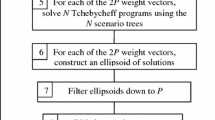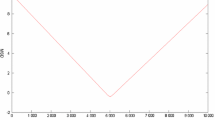Abstract
Computing optimal stochastic portfolio execution strategies under an appropriate risk consideration presents many computational challenges. Using Monte Carlo simulations, we investigate an approach based on smoothing and parametric rules to minimize mean and Conditional Value-at-Risk (CVaR) of the execution cost. The proposed approach reduces computational complexity by smoothing the nondifferentiability arising from the simulation discretization and by employing a parametric representation of a stochastic strategy. We further handle constraints using a smoothed exact penalty function. Using the downside risk as an example, we show that the proposed approach can be generalized to other risk measures. In addition, we computationally illustrate the effect of including risk on the stochastic optimal execution strategy.



Similar content being viewed by others
References
Alexander, S., Coleman, T. F., & Li, Y. (2006). Minimizing VaR and CVaR for a portfolio of derivatives. Journal of Banking & Finance, 30(2), 583–605.
Almgren, R., & Chriss, N. (2000/2001). Optimal execution of portfolio transactions. The Journal of Risk, 3(2), 5–39.
Almgren, R., & Lorenz, J. (2007). Adaptive arrival price. In B. R. Bruce (Ed.), Algorithmic trading III: precision, control, execution (pp. 59–66). Institutional Investor Journals.
Almgren, R. F. (2008). Execution costs. In Encyclopedia of quantitative finance (pp. 1–5).
Artzner, P., Delbaen, F., Eber, J., & Heath, D. (1997). Thinking coherently. Risk, 10, 68–71.
Artzner, P., Delbaen, F., Eber, J., & Heath, D. (1999). Coherent measures of risk. Mathematical Finance, 9, 203–228.
Bertsimas, D., & Lo, A. W. (1998). Optimal control of execution costs. Journal of Financial Markets, 1(1), 1–50.
Bertsimas, D., Lo, A. W., & Hummel, P. (1999). Optimal control of execution costs for portfolios. Computing in Science & Engineering, 1(6), 40–53.
Coleman, T. F., & Li, Y. (1996). An interior trust region approach for nonlinear minimization subject to bounds. SIAM Journal on Optimization, 6(2), 418–445.
Coleman, T. F., & Verma, A. (2000). ADMIT-1: automatic differentiation and MATLAB interface toolbox. In ACM transactions on mathematical software (pp. 150–175).
Coleman, T. F., Li, Y., & Patron, C. (2007). Total risk minimization. In J. R. Birge & V. Linetsky (Eds.), Handbook of financial engineering (pp. 593–635). Amsterdam: Elsevier.
de Farias, D. P., & Roy, B. V. (2003). The linear programming approach to approximate dynamic programming. Operations Research, 51(6), 850–865.
Downward, A., Young, D., & Zakeri, G. (2012, submitted). Electricity contracting and policy choices under risk-aversion. Operations Research, 1–43.
Duffie, D., & Pan, J. (1997). An overview of value at risk. The Journal of Derivatives, 4(3), 7–49.
Fabozzi, F. J., Kolm, P. N., Pachamanova, D., & Focardi, S. M. (2007). Robust portfolio optimization and management. New York: Wiley.
Follmer, H., & Schied, A. (2011). Stochastic finance: an introduction in discrete time (3rd ed.). Berlin: de Gruyter.
Goh, M., & Meng, F. (2009). A stochastic model for supply chain risk management using conditional value at risk. In T. Wu & J. V. Blackhurst (Eds.), Managing supply chain risk and vulnerability: tools and methods for supply chain decision makers (pp. 141–157). Berlin: Springer.
Griewank, A., & Corliss, G. (1991) SIAM proceedings series: In EDS, automatic differentiation of algorithm: theory, implementation and applications.
Grossman, S. J., & Vila, J. (1992). Optimal dynamic trading with leverage constraints. Journal of Financial and Quantitative Analysis, 27(2), 151–168.
Haugh, M. B., & Lo, A. W. (2001). Computational challenges of financial engineering. Computing in Science & Engineering, 3, 54–59.
Heston, S. (1993). A closed-form solution for options with stochastic volatility with applications to bond and currency options. The Review of Financial Studies, 6(2), 327–343.
Huberman, G., & Stanzl, W. (2004). Price manipulation and quasi-arbitrage. Econometrica, 72(4), 1247–1275.
Huberman, G., & Stanzl, W. (2005). Optimal liquidity trading. Review of Finance, 9(2), 165–200.
Kirilenko, A., Samadi, M., Kyle, A. S., & Tuzun, T. (2011, working paper). The flash crash: The impact of high frequency trading on an electronic market. 1–63.
Longstaff, F. A., & Schwartz, E. S. (2001). Valuing American options by simulation: a simple least-squares approach. The Review of Financial Studies, 14(1), 113–147.
Merton, R. C. (1976). Option pricing when underlying stock returns are discontinuous. Journal of Financial Economics, 3(1–2), 125–144.
Moazeni, S., Coleman, T. F., & Li, Y. (2010). Optimal portfolio execution strategies and sensitivity to price impact parameters. SIAM Journal on Optimization, 20(3), 1620–1654.
Moazeni, S., Coleman, T. F., & Li, Y. (2013). Optimal execution under jump models for uncertain price impacts. Journal of Computational Finance, 16(4), 1–44.
Moazeni, S., Coleman, T. F., & Li, Y. (2013). Regularized robust optimization: The optimal portfolio execution case. Computational Optimization and Applications, 55(2), 341–377.
Nocedal, J., & Wright, S. J. (2000). Numerical optimization. Berlin: Springer.
Pérold, A. (1988). The implementation shortfall: paper versus reality. The Journal of Portfolio Management, 14, 4–9.
Pflug, G. C., & Romisch, W. (2007). Modeling, measuring and managing risk. Singapore: World Scientific.
Powell, W. B. (2011). Approximate dynamic programming: solving the curses of dimensionality (2nd ed.). New York: Wiley.
Rockafellar, R. T., & Uryasev, S. (2000). Optimization of conditional value-at-risk. The Journal of Risk, 2(3), 21–41.
Shapiro, A. (2008). Stochastic programming approach to optimization under uncertainty. Mathematical Programming, 112(1), 183–220.
Shapiro, A., Dentcheva, D., & Ruszczynski, A. (2009). Lectures on stochastic programming: modeling and theory (MPS-SIAM series on optimization). Philadelphia: SIAM.
Wu, D. D., & Olson, D. (2010). Enterprise risk management: a DFA VaR approach in vendor selection. International Journal of Production Research, 48(16), 4919–4932.
Yau, S., Kwon, R. H., Rogers, J. S., & Wu, D. (2011). Financial and operational decisions in the electricity sector: contract portfolio optimization with the conditional value-at-risk criterion. International Journal of Production Economics, 134(1), 67–77.
Author information
Authors and Affiliations
Corresponding author
Rights and permissions
About this article
Cite this article
Moazeni, S., Coleman, T.F. & Li, Y. Smoothing and parametric rules for stochastic mean-CVaR optimal execution strategy. Ann Oper Res 237, 99–120 (2016). https://doi.org/10.1007/s10479-013-1391-7
Published:
Issue Date:
DOI: https://doi.org/10.1007/s10479-013-1391-7




